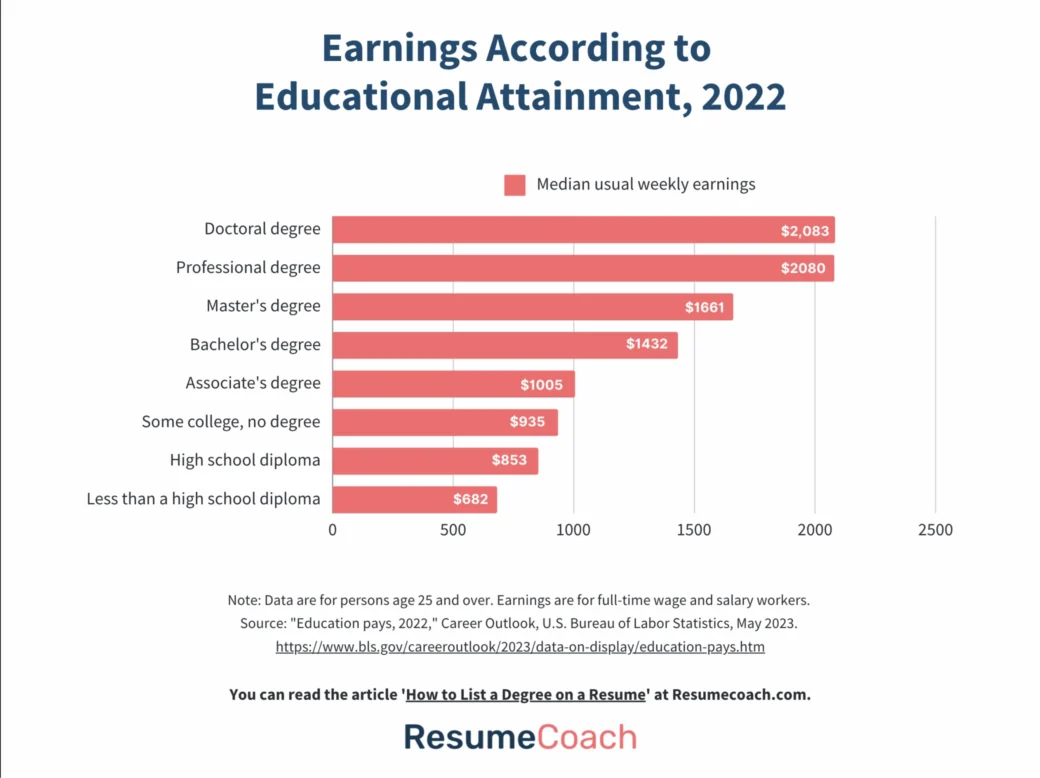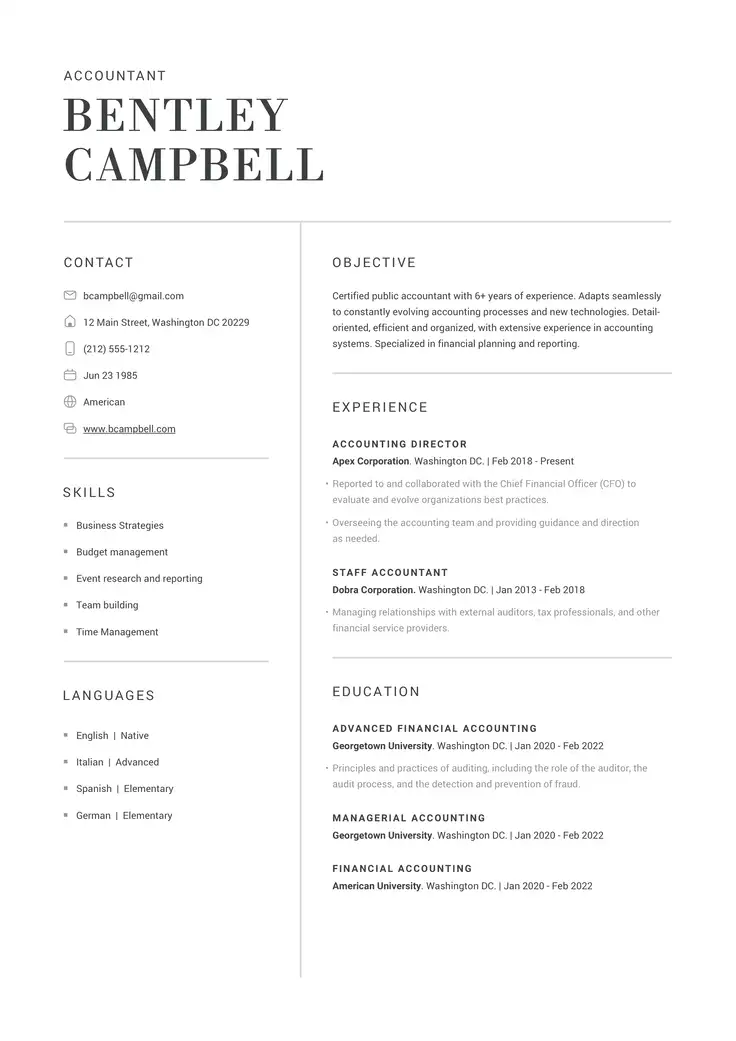You know that education is important to achieving your career goals. Having a degree or diploma says something about you as a future employee.
In order to benefit from your education, you have to communicate it. You can use our AI resume builder to make listing your education easy.
According to the U.S. Bureau of Labor Statistics (BLS), median weekly earnings increase based on the level of education completed, which you can see in the graph below:

But you may wonder how to list your educational qualifications on your resume, especially if it’s complicated.
Below, we’ll go over how to list your bachelor’s or master’s degree on your resume, how to present your degrees in the correct order, and even how to list an associate’s degree, and any other educational accomplishments.
How To Write a Degree on a Resume
Many types of degrees exist, but the same basic format is used for each in your resume education section. Here, we’ll use a bachelor’s degree as an example.
You’ll need to include the following details to display your credentials in an organized manner:
- Type of degree earned
- Major (separate a double major with the “&” symbol)
- Name of the school
- Location of the school (city and state)
You can also choose to list the year you graduated. However, depending on when you finished college, it may be better to add it or leave it out.
If you have more than 5 years of experience, you don’t need to list the year you graduated in your resume. Including a distant year can expose you to ageism or make your degree seem dated.
How to list a minor on a resume
If your minor supports your career goals and is relevant to the job you’re applying for, include it in the same entry as your major. If space allows, put it on the same line; if not, use the next line.
For example, a leadership minor can strengthen your qualifications for a role in HR, education, or the corporate sphere.
Example
Bachelor of Science in Psychology, Minor in Leadership
University of Tennessee | Knoxville, TN
Examples of Degrees on a Resume
When you include your degree on a resume, it’s going to follow the same basic format explained above. However, there are minor differences based on the degree involved.
Consider the following examples of Bachelor’s, Bachelor of Science, and unfinished degrees.
Bachelor’s degree resume example
A bachelor’s degree is an undergraduate degree that takes 4 or more years of study. There are many types of bachelor’s degrees, including Bachelor of Arts (B.A.), Bachelor of Business Administration (B.B.A.), Bachelor of Education (B.Ed.), and more.
Your entry might look something like this:
Example
Bachelor of Fine Arts (B.F.A.) in Graphic Design, Minor in Marketing
Rhode Island School of Design | Providence, RI, 2025
Remember to spell out the name of your degree rather than just abbreviating it. If you need to use an abbreviation to save space, you can use BA for Bachelor of Arts or BS for Bachelor of Science.
Before using any less abbreviations, such as B.F.A or B.Des, think seriously about whether the meaning will be clear to your hiring manager.
Notice, too, that you won’t be using an apostrophe. Correctly write “Bachelor of,” not “Bachelor’s degree in…”
Bachelor of Science resume example
Let’s say you’ve specifically graduated with a Bachelor of Science (BS) degree.
Remember to include any noteworthy honors or distinctions along with your degrees, if you graduated Cum Laude, or if you graduated with a GPA over 3.5, if it’s relevant to the position you are applying to.
Here’s an example:
Example
Bachelor of Science in Business Administration
Double Major: Marketing & Management, Minor in Graphic Design
State University, 2024
- Achievements: Graduated Cum Laude, President of the Business Club (2019-2020)
- Relevant Coursework: Strategic Marketing, Operations Management, Organizational Behavior
Unfinished degree on a resume example
What if you are currently working on your degree, but have not yet graduated? In-progress degrees on your resume show employers that you’re actively working toward the skills you’ll need.
You’ll list it similarly to the degrees above, with the phrase “Expected graduation in [year].” Alternatively, you can list the expected future graduation date.
On the other hand, what if you worked hard in college but did not finish your degree? If relevant to the position you’re applying for, this experience can still be placed on your resume. Include your relevant classes and focus on the transferable skills you picked up while studying.
Consider this unfinished degree on a resume example:
Example
2023 to Present
Austin Peay State University, Clarksville, TN
Completed 48 credits toward a Bachelor of Arts in English
- Relevant Coursework: Writing for the Internet, Writer’s Marketplace
- GPA 3.95
How To Write an Associate’s Degree on a Resume
While it may take less time to get an associate’s degree–typically 2 years–it can still be a valuable addition to your resume. You’ll need to highlight your achievements, just like on a bachelor’s or master’s degree.
Generally, you will record your associate’s degree in the format of the example below:
Example
Associate of Applied Science in Graphic Design
Springfield Community College, 2021
- Relevant Coursework: Digital Illustration, Typography, Web Design
- Honors: Graduated with Distinction
As a general rule, you should spell out the name of the degree rather than abbreviating it. This prevents confusion on the part of the recruiter. Also, never write “Associate’s Degree” on your resume. It should always be listed as the proper degree name, without an apostrophe “s”.
If you’re running out of space on your one-page resume, you can opt to abbreviate. These are common associate’s degree abbreviations and their meanings:
- AA means Associate in Arts
- AAB means Associate of Applied Business
- AAS means Associate in Applied Science
- AAT means Associate of Arts in Teaching
- ABA means Associate of Business Administration
- AS means Associate in Science
Depending on your college, your degree may be called “Associate of” or “Associate in.” Double-check to make sure you are using the correct terminology.
How To List a Master’s Degree on a Resume
Once you’ve obtained a bachelor’s degree, you might get a master’s degree. These graduate degrees usually require 2 additional years of study.
Always list your master’s degree first and your bachelor’s degree second. List your degrees in reverse chronological order; place your highest level of education at the top of your education section, and continue from there.
Like previously discussed degrees, your master’s degree listing will include the standard format, degree name, institution, location, and optionally, dates.
If you need to abbreviate, the following are common master’s degree abbreviations:
- A.M., M.A., or MA for Master of Arts
- M.B.A. or MBA for Master of Business Administration
- M.E., ME, MEng, or M.Eng. for Master of Engineering
- M.Ed. or MEd for Master of Education
- M.S., MS, M.Sc., or MSc for Master of Science
- M.S.Met. for Master of Science in Metallurgical Engineering
Your master’s degree might look like this on your resume:
Example
Master of Public Health (M.P.H.) — Epidemiology
University of North Carolina at Chapel Hill — 2024
- GPA: 3.9/4.0
- Relevant Coursework: Biostatistical Methods, Global Health Policy, Infectious Disease Modeling, Health Data Analytics
With these tips, you can easily master your resume education section. But if you want to guarantee your education section is ready to impress, use our resume checker to guarantee your education section is ready to impress.
Frequently Asked Questions (FAQs)
Adding your associate’s degree depends on what you majored in and how relevant the degree is to the job you’re seeking.
Just as you don’t list your high school diploma on your resume if you have a college degree, you don’t have to list your associate’s degree if you have a higher degree.
However, if your associate’s degree directly reinforces your suitability for the job, feel free to include it. If you need to fill some space on your resume, include it. But don’t sacrifice other, more relevant information to do so. If leaving it off would allow you to describe one more relevant job experience or skill, opt for relevancy instead.
Each type of degree will follow the same basic format:
Name of Degree in [Major]
School Name | Location, Year (optional)
Typically, degrees will be listed in a descending order of how many years it took to obtain them, but this can differ depending on your specific experiences:
- Associate’s (2 years)
- Ph.D. (8+ years)
- Master’s (2 additional years)
- Bachelor’s (4 years)
Since it’s the highest distinction you can earn in education, you’ll want to place your Ph.D. at the top of your education section, and even show it off in your summary.
Here’s how it should look when written on a resume:
Ph.D. in Computer Science, Focus on Artificial Intelligence, ABC Institute, 2024
- Dissertation: “Deep Learning Approaches to Natural Language Processing”
- Advisor: Dr. John Doe
- Research Interests: Machine Learning, Neural Networks, Sentiment Analysis
- Publications: 3 peer-reviewed articles published in leading journals
- Teaching Experience: Graduate Teaching Assistant, Introduction to Programming, Prestigious Institute (2022-2024)
- Awards: Best Paper Award, International Conference on Machine Learning (2022)
By placing it high in your education section, it can help set you apart.
Related Blogs





